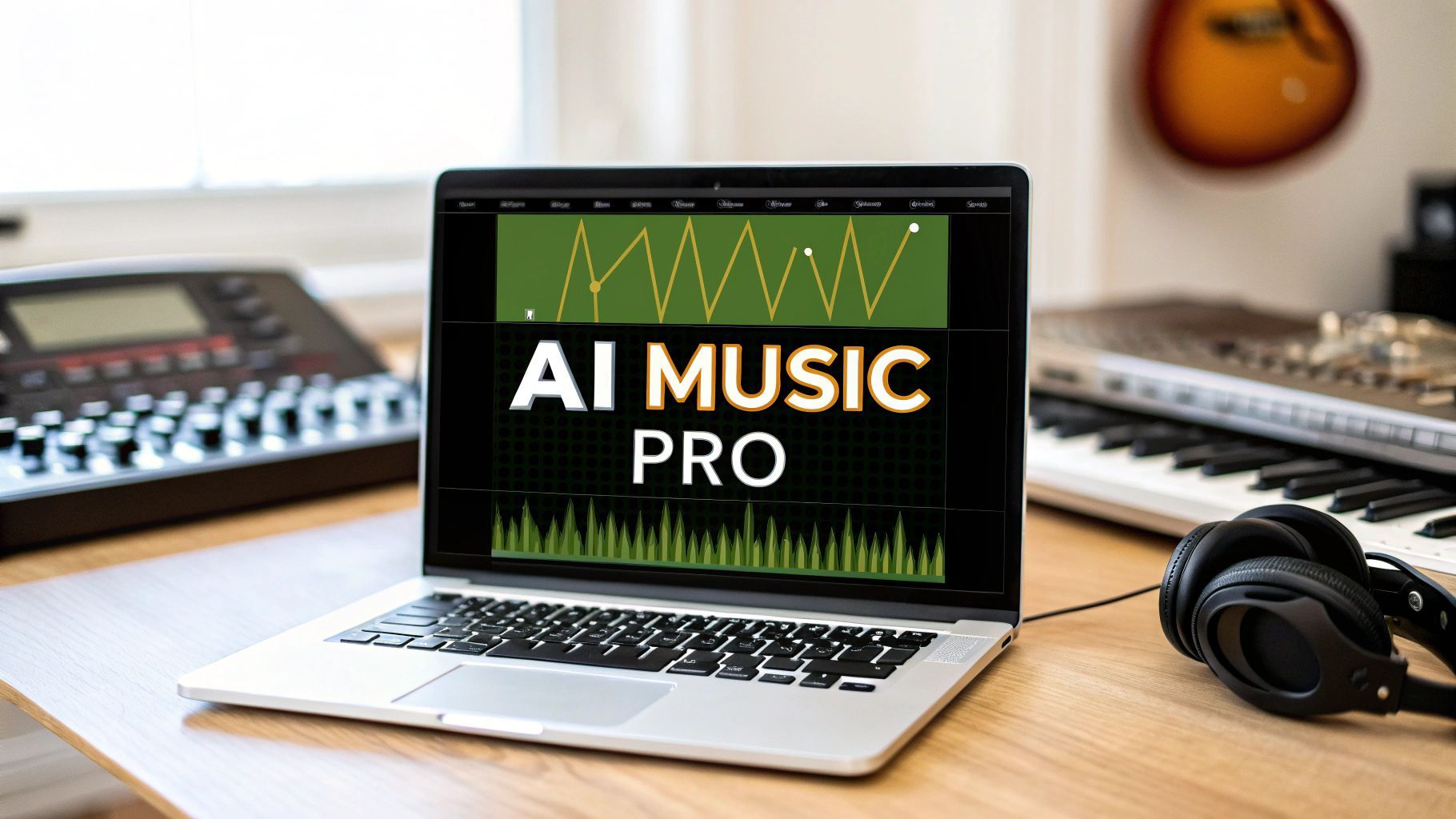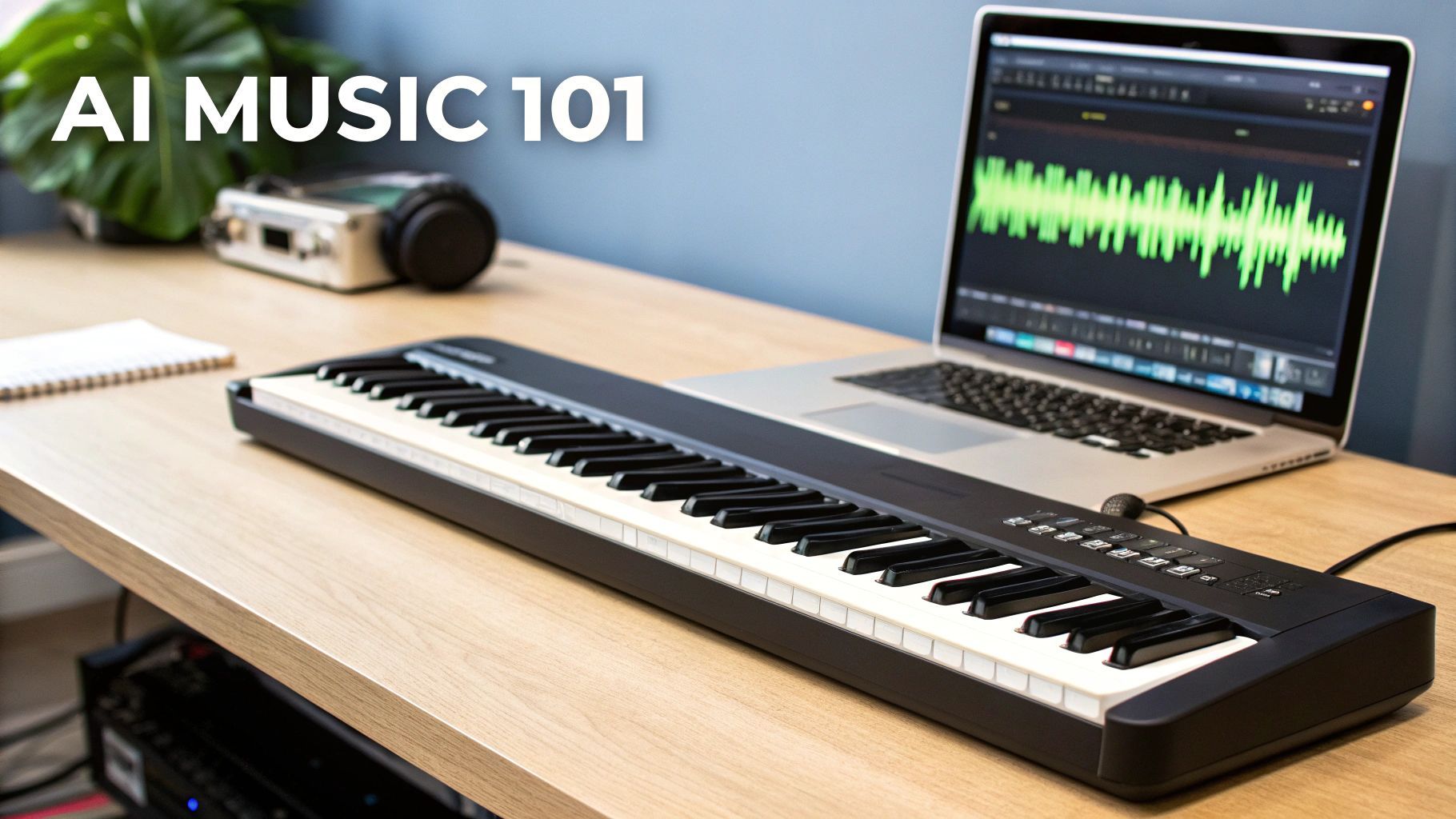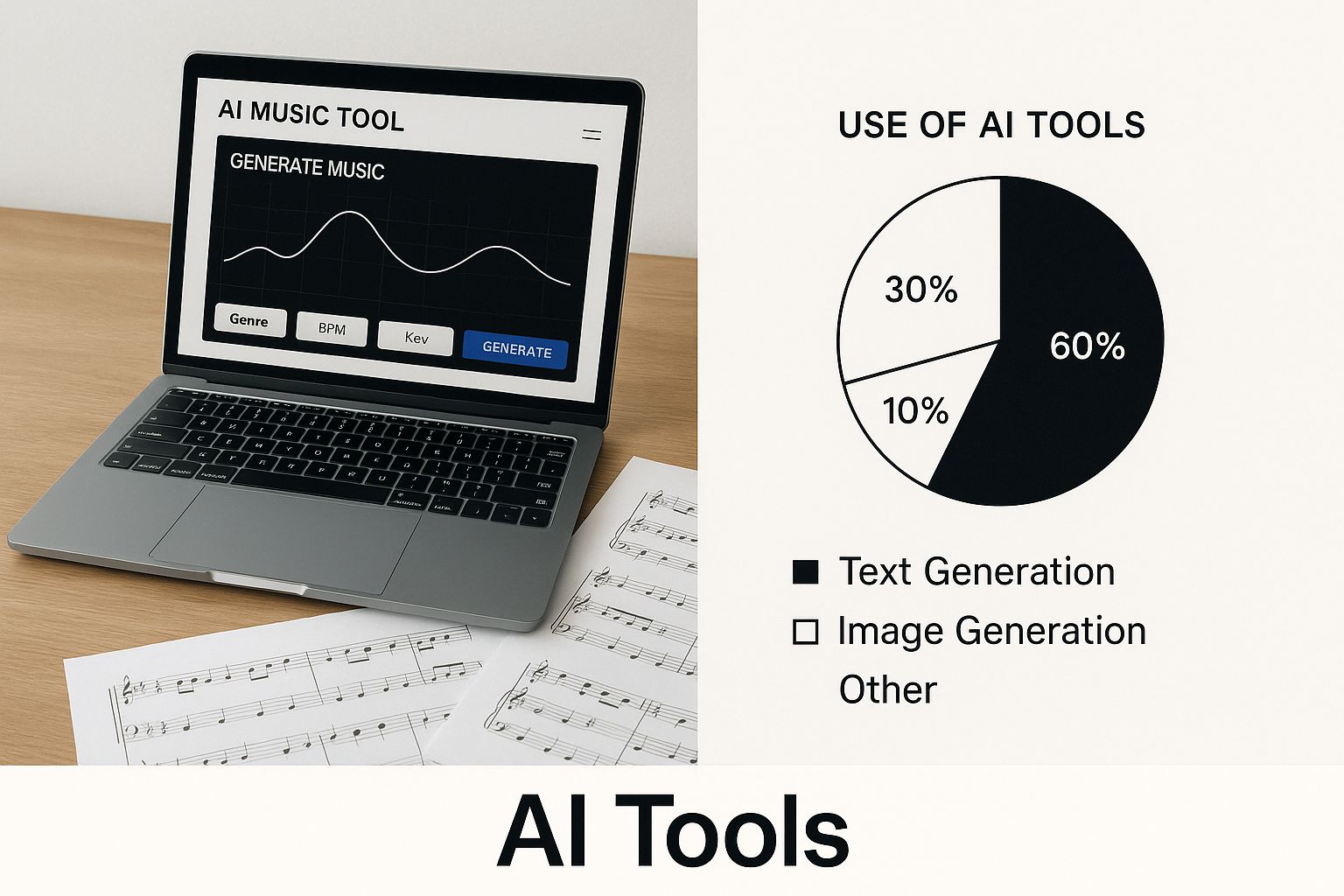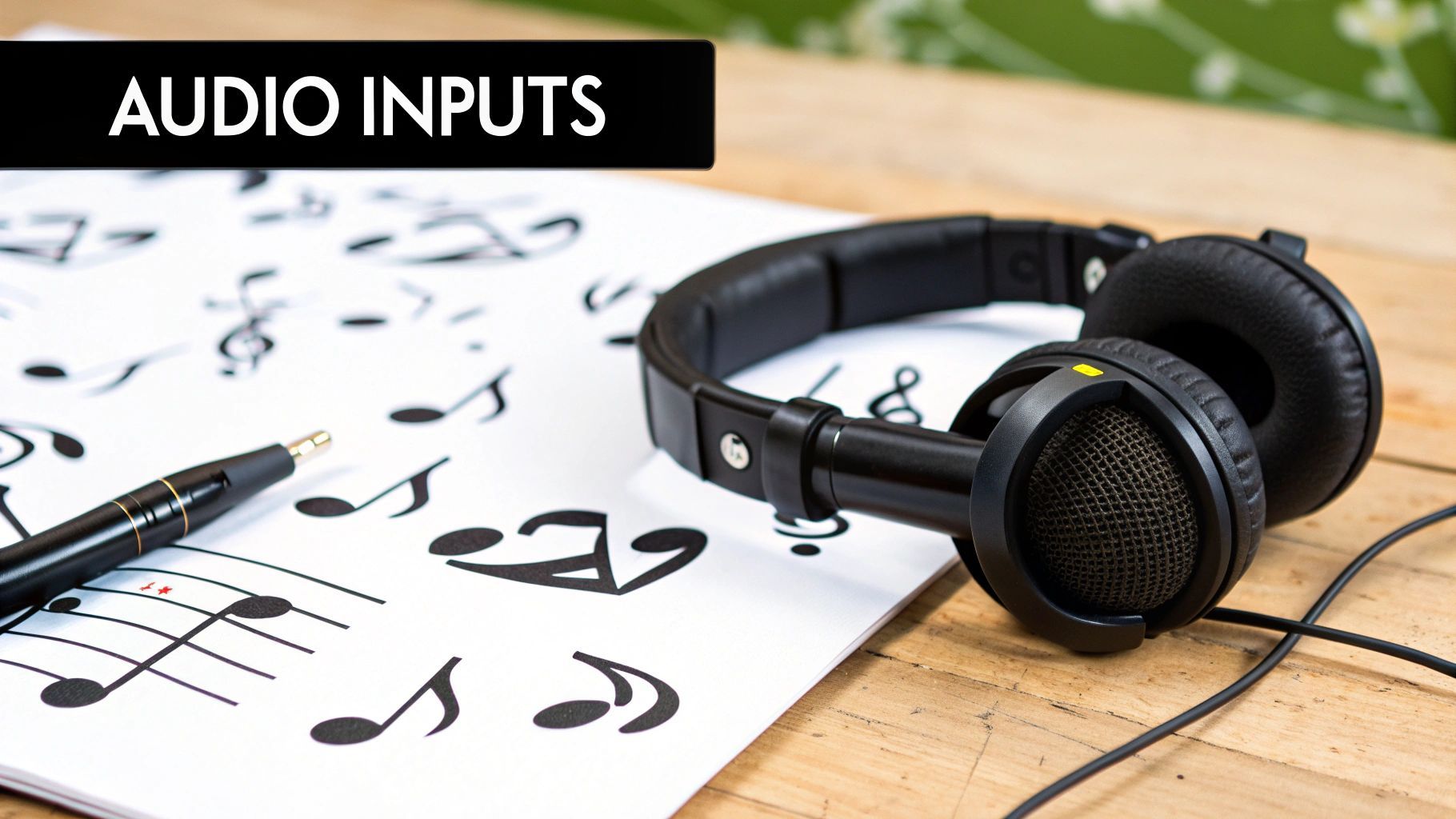Top 12 AI Tools for Content Marketing in 2025




Discover how to make AI generated music with this hands-on guide. Learn to select the right AI tools, master prompting, and finalize your tracks.
Ever wondered how you can create a piece of music just by describing it? That's the magic of AI music generation. You feed a specialized tool a text prompt—think "lo-fi hip hop beat for studying, chill vibes, rainy day"—and it spits out a full-fledged audio track. It's a wild new way to make music, and you don't need a lick of technical skill to get started.
Welcome to the new frontier of making music. Gone are the days when you needed a sprawling, expensive studio to bring an idea to life. Today, all you need is a clever thought and the right AI tool to turn it into a fully produced song.
We're about to pull back the curtain on this whole AI music thing. It's not here to replace artists; think of it as a powerful new instrument in your creative toolkit. This guide will show you exactly how to generate custom AI music for anything—from a slick background score for your next YouTube video to some truly weird, experimental sounds for a personal project.
Take a look at a typical AI music generator's interface. It’s a testament to simplicity.

See that? No complicated dials or faders. You just tell the AI what you want to hear, and it gets to work.
Let’s be clear: this is more than just a fleeting gimmick. It's a genuine shift in how we think about creative work. The global market for AI in music is absolutely booming, driven by creators, producers, and even streaming platforms jumping on board.
Back in 2023, the market was valued at around $3.9 billion. That number is projected to rocket to an incredible $38.71 billion by 2033. This isn't just noise; it's a fundamental change in the industry.
The real beauty of it is that the AI becomes your creative partner. It handles all the complex music theory and production headaches, leaving you free to focus on the big picture—your vision.
This opens up a world of possibilities for all sorts of people:
Content Creators: Need a unique, royalty-free track for your latest video or podcast? You can generate one in the time it takes to make a cup of coffee.Indie Game Developers: Imagine creating an entire, perfectly-themed soundtrack for your game without blowing your budget. Now you can.Musicians and Producers: Use an AI music generator to bust through writer's block, quickly sketch out new song ideas, or discover sonic textures you never would have thought of on your own.
Ultimately, learning how to whip up AI-generated music is about adding another powerful tool to your creative arsenal. It's about bringing your musical ideas to life faster and more vibrantly than ever, breaking down the barriers that once kept people from creating.
Picking the right AI music generator is a lot like auditioning a new bandmate. You're looking for a creative partner that just gets it, whether you're trying to whip up some chill lo-fi beats for a study stream or score a dramatic scene for your next short film. Let's be real, the options out there can feel a bit overwhelming. But nailing this first step is crucial if you want to make AI-generated music that actually sounds like you.
Don't sweat the crowded market. Most of these tools fit into a few main buckets, each designed for a different kind of creative itch. You've got your simple text-to-music platforms, which are awesome for spitting out ideas fast—just type a sentence and get a whole track. Then, on the other end of the spectrum, you have these beastly production suites that give you insane control over every little detail, almost like a traditional Digital Audio Workstation (DAW).
Think of it this way: AI is just another instrument in your studio, a powerful new way to get the sounds in your head out into the world.

The image above really nails this idea, blending classic sheet music with the sleek, modern interfaces of AI tools. It shows they're not separate worlds—they’re part of the same creative journey.
When you're test-driving different generators, keep an eye out for a few key things. The goal is to find a platform that feels less like a clunky piece of software and more like a genuine collaborator.
Here's what I always look for:
Is it fun to use? Seriously, if you can't jump in and create something cool within minutes, you'll probably get frustrated and quit. A clean, intuitive interface keeps the creative vibes flowing. Can you make it your own? How much can you actually mess with the music? You'll want options to adjust the tempo, change the key, swap out instruments, and even rearrange the song structure. How good does it sound? Does the output sound polished and professional, or does it have that weird, robotic sheen? Listen closely for any strange audio artifacts. What can you do with it afterward? Can you download high-quality WAV files? Even better, can you export individual instrument tracks (stems)? That's a huge win for anyone who wants to mix the final track in their own software.
The buzz around generative AI music is no joke. The market was valued at a cool USD 440 million in 2023 and is projected to explode to USD 2.79 billion by 2030. That's a massive stamp of approval from creators everywhere.
My two cents: Your choice of tool sets the stage for what you can create. A simple generator is perfect for speed, but a more complex suite will unlock way more artistic depth. Pick what feels right for your skills today and where you want to be tomorrow.
To help you get a clearer picture, I've put together a quick table comparing the different types of AI music tools. This should give you a good idea of which category might be the best fit for your next project.
| Feature | Text-to-Music (e.g., Suno) | Stem-Based (e.g., LALAL.AI) | Full Production Suite (e.g., Soundful) |
|---|---|---|---|
| Primary Use | Rapid idea generation from text prompts | Isolating or removing instruments/vocals | Creating complete, royalty-free tracks |
| Control Level | Low to moderate (prompt-based) | High (focused on separation) | Very high (mood, genre, instruments) |
| Ease of Use | Very easy | Easy, with a specific function | Moderate learning curve |
| Best For | Social media creators, quick mockups | DJs, producers, remix artists | Filmmakers, podcasters, game developers |
Ultimately, the best tool is the one that gets out of your way and lets you create. Don't be afraid to try a few free trials to see what clicks.
And hey, music isn't just about the instruments. If you're looking to add vocals or narration, you should definitely learn how to use AI voice for perfect audio. It's a whole other dimension of AI-powered creativity. For a deeper dive into all this, our complete https://sendfame.com/how-to-make-music-ai-guide breaks everything down even further.

Alright, this is where the magic really happens. Prompting an AI for music isn't just about typing in a few words; it's a creative skill, a delicate dance between art and science. If you just type "happy song," you're going to get something that sounds like it was made for a corporate training video. It's elevator music, plain and simple.
But once you learn to speak the AI’s language? An entire universe of sound opens up.
Think of yourself as a director guiding an orchestra of ones and zeros. Your prompt is the script, and the more vivid and detailed you make it, the more breathtaking the performance will be. Generic instructions get you generic results. Every time.
So, let's ditch the one-word prompts and start layering our descriptions like a real producer. The trick is to paint a complete picture for the AI, combining mood, genre, and specific instruments to bring your idea to life.
Instead of just "sad piano music," try giving it some soul: "melancholy sunrise over a rainy city street, slow tempo, sparse piano melody, gentle string pads, reflective mood."
See the difference? We didn't just ask for a feeling; we gave the AI a scene, a tempo, and a specific set of tools. That's the secret sauce to creating AI music that actually sounds like it was made with intention.
Key Takeaway: The best prompts are a cocktail of descriptors. Think of it as mixing a drink—a little bit of mood, a splash of genre, a twist of instrumentation—to create the perfect sonic flavor.
Here’s a simple framework I use to build powerful prompts:
Mood & Vibe: Always start with the feeling. Is it uplifting, suspenseful, nostalgic, chaotic, or serene? This sets the emotional foundation. Genre & Style: Get specific. Don't just say "rock." Is it gritty 70s garage rock? Psychedelic indie pop? Or maybe 80s synthwave with a modern twist? The details matter. Instrumentation: Call out the instruments you want to hear. Asking for a funky slap bass, soulful Rhodes piano, and crisp 808s gives the AI a clear texture to build. Tempo & Rhythm: Guide the pace. Use phrases like slow and hypnotic, fast-paced four-on-the-floor beat, or a driving drum and bass rhythm at 170 BPM.
If you really want to level up your game, it helps to understand the fundamentals of prompt engineering. The same principles that work for generating text and images are gold when it comes to music.
Here's a pro tip: sometimes, telling the AI what to leave out is just as crucial as telling it what to include. This is where negative prompts become your best friend.
Let's say you're trying to make a chill lo-fi track, but the AI keeps throwing in a cheesy saxophone solo. No problem. You just refine the prompt.
Your next attempt could look something like this: "lo-fi hip hop beat for studying, calm, rainy day vibes --no saxophone, --no vocals." Most platforms use a "--" prefix or have a separate box for these negative commands.
This technique is a lifesaver for dialing in the exact sound you want and steering the AI away from common clichés. For a deeper dive into these kinds of tricks, check out our guide on how to https://sendfame.com/blog/generate-music-with-ai.
Referencing specific artists is another killer shortcut. A prompt like, "Acoustic folk song in the style of early Bob Dylan, harmonica, raw vocals," gives the AI a rich, instant reference point. It knows that sonic world.
Start playing with these layers, and before you know it, you'll be conducting your AI orchestra like a seasoned pro.
Alright, so the AI has handed you a track. That first generation is rarely the finished article. Think of it more like a really promising demo or a lump of clay. The real magic happens when you roll up your sleeves and start shaping it into something that’s truly yours.
This is where you stop being a prompter and start being a producer. The process is all about iteration. Don’t just take the first thing it gives you and call it a day! Jump back in, play with the settings, and start tweaking. Maybe that chorus feels a little flat—regenerate it. Feel like the tempo is dragging? Nudge it up a few BPM. Not sold on that synth lead? Swap it for a gritty electric guitar.
The best way to think about this process is as a partnership. The AI is your endlessly patient, slightly weird, but super-fast creative partner. It throws ideas at the wall, and you’re the one with the vision to decide what sticks.
Here’s a trick I use all the time: create a bunch of different versions. Tweak one or two small things in your prompt and see what happens. Generate a version with a driving, four-on-the-floor beat, then another with a laid-back, chill-hop rhythm. You can then listen back and steal the best bits from each one, almost like you're sampling yourself.
This back-and-forth approach is quickly becoming the standard for creators. In North America, which held about 40% of the AI music generator market share in 2023, this iterative workflow is exploding. It's a massive market, fueled by a booming tech scene and a hungry entertainment industry. Creatives are folding these tools into their projects left and right, and it’s a big reason the market is projected to grow at 22.5% through 2032. You can get a deeper dive into these numbers from the market analysis by DataIntelo.
Pro Tip: Hoard everything. Seriously. Even the generations that make you cringe might have a cool drum fill or a bizarre synth texture you can salvage later. Never delete a happy accident.
Ready to get serious? The single biggest leap in quality comes from moving your project out of the AI tool and into a Digital Audio Workstation (DAW). This is the software that professional producers live in.
The best AI music generators will let you download your song as individual instrument tracks, which are called stems. This is a total game-changer. Instead of one baked-in audio file, you get separate files for the drums, bass, vocals, keys—everything.
Here's why stems are your new best friend:
Ultimate Mix Control: Inside a DAW like GarageBand (which is free on Apple devices) or a more powerful one like Ableton Live, you can finally balance everything perfectly. Is the kick drum overpowering the melody? Just pull its fader down.Time to Add Some Flavor: This is where you can add effects. Drench the vocals in reverb to make them sound epic, or slap some crunchy distortion on the bass to give it more attitude. You have an entire sonic toolbox at your fingertips.Become the Arranger: Don't like the song structure the AI came up with? No problem. In a DAW, you can literally chop up the song sections and rearrange them however you want. Move the bridge, double the chorus, create a brand-new intro—it's all up to you.
Pulling your stems into a DAW is what separates a neat tech demo from a polished, release-ready song. It's how you put your unique stamp on the music and add the human touch that AI just can't replicate.
Alright, you’ve wrestled with prompts, fine-tuned the parameters, and cooked up an AI track that sounds amazing. Now what? Before you blast it out to the world, there are a couple of final, but absolutely critical, hurdles: getting the file out of the generator and figuring out what you can legally do with it.
This is the moment your creation graduates from a fun experiment into a tangible piece of art. The first decision you’ll make is what kind of file to export. This isn't just nerdy tech stuff—it's a choice that dictates how and where your music can shine.
Think of audio formats like different types of shipping containers. Some are small and efficient, others are massive and built for high-value cargo. Your choice depends entirely on what you plan to do with the music.
You'll mainly run into two big players:
MP3 (MPEG Audio Layer III): This is the undisputed champion of the internet. MP3s are compressed, which shrinks the file size down to something you can easily email or stream. The compromise is a tiny bit of lost audio quality, but honestly, for most everyday listening on earbuds or laptop speakers, you'd be hard-pressed to notice. WAV (Waveform Audio File Format): This is the format for purists and pros. WAV files are completely uncompressed, delivering the full, unadulterated sound exactly as it was generated. The files are huge, but the quality is pristine—this is what you want for a Spotify release, a film score, or any serious audio project.
Once you have that beautiful AI track, you'll need a way to send it around, especially if you're dealing with those massive WAV files. That's where solid file sharing platforms come in handy for collaborating with other artists or sending masters to a distributor.
My personal rule is pretty straightforward. If it’s destined for a professional release or any high-fidelity situation, I always go with WAV. For everything else—a quick demo, a social media post, or background music for a website—MP3 is the perfect, hassle-free option.
Okay, let's talk about the elephant in the room. Can you actually make money from this track? The answer is a big, fat "it depends"—specifically on the terms of service of the AI tool you used. Do not, under any circumstances, just skim this part.
Most AI music generators use a freemium model. If you're on a free plan, you'll likely get a license for personal use only. That means you can listen to it yourself and share it with friends, but you can't drop it into a monetized YouTube video or sell it. To get the green light for commercial use, you’ll almost certainly have to upgrade to a paid subscription.
You need to put on your detective hat and scan their terms for a few key phrases:
Royalty-Free: This is a big one. It means that once you have the license, you can use the music in your projects without paying ongoing fees every time someone plays it. Commercial License: This is your golden ticket. It's the explicit permission slip that says you can use the track in projects that are designed to make money. Ownership: This is crucial. Who actually owns the copyright? Some services grant you full ownership of the track, while others simply give you a license to use it while they retain the copyright. Know the difference!
Getting this figured out before you even think about a release will save you a world of headaches. Once you've got a commercially-cleared track ready to go, the real fun begins: getting people to hear it. For some killer strategies on that front, definitely check out our guide on how to promote music online. Nail the legal stuff first, and you can share your work with total confidence.
Jumping into AI music can feel a bit like you're messing with a futuristic synthesizer from a sci-fi movie. It's totally normal to have some questions buzzing around your head. Let's tackle the big ones so you can get back to making music without any lingering doubts.
Ah, the million-dollar question. The short answer? It depends. The long answer is that it all comes down to the terms and conditions of the specific AI tool you’re using. Seriously, don't just scroll past that wall of text—read the fine print.
Many of these platforms offer commercial licenses, but they're almost always part of a paid subscription. If you're jamming on a free plan, chances are the music you create is for personal use only. That means no slapping it on your monetized YouTube channel, podcast, or that ad you're running for your side hustle. Upgrading to a paid plan is usually what grants you the golden ticket to use your tracks in projects that actually make money.
Look, the rule of thumb is simple: always, always check the licensing agreement before you hit publish. A couple of minutes of reading now can save you from a world of copyright pain later.
The magic isn't in the first click; it's in the follow-through. Think of the AI's first output as a rough sketch, not the finished painting. The real artistry happens when you start tweaking and polishing that initial idea.
To inject some human soul into your AI-generated tunes, try this approach:
Generate, Then Generate Again: Never settle for the first thing the AI gives you. Tweak your prompt slightly and create a few different versions. You might snag the perfect bassline from one and a killer synth lead from another.Play Producer: Now, listen back and cherry-pick the absolute best parts from each variation. This is where you start acting like a record producer, curating the most powerful moments to build your final track.The DAW is Your Best Friend: The single most effective trick is to export the individual instrument tracks (often called "stems") and drop them into a Digital Audio Workstation (DAW) like GarageBand or Ableton Live. Inside your DAW, you can nudge notes to create tiny timing imperfections, automate volumes, and add effects. It’s these "flaws" that make music breathe and feel truly alive.
Nope! Not at all. And honestly, that’s what makes this so cool. AI music generators are built to break down the barriers to creating music. You don't need to know the difference between a Lydian mode and a Dorian scale to whip up a track that sounds epic and adventurous.
You just describe the vibe you're after. Something like "sad, lo-fi hip hop beat for studying" or "upbeat, funky 80s synthwave" is all you need. The AI does all the heavy lifting with scales, chords, and harmonies behind the curtain.
While knowing a bit of theory can help you write more nuanced prompts, it's absolutely not a requirement to get started. These tools are for everyone, whether you're a seasoned musician or someone who just loves to listen.
Ready to stop wondering and start creating? The SendFame AI Music Generator is your playground for turning those wild musical ideas into reality. Dive in and make your first track today at https://sendfame.com
Create Epic
SendFame